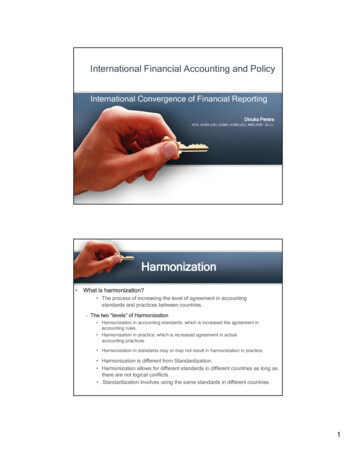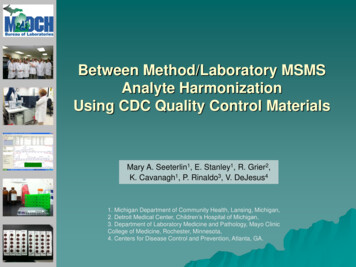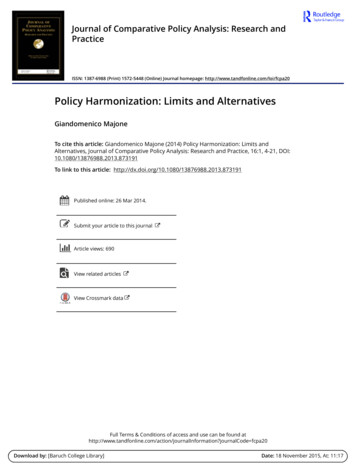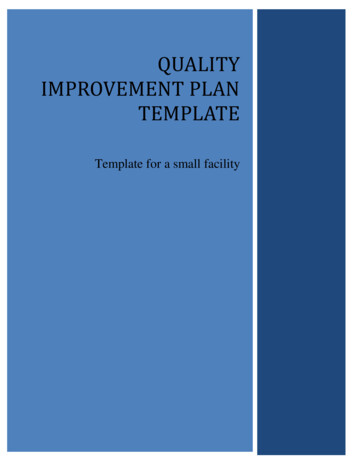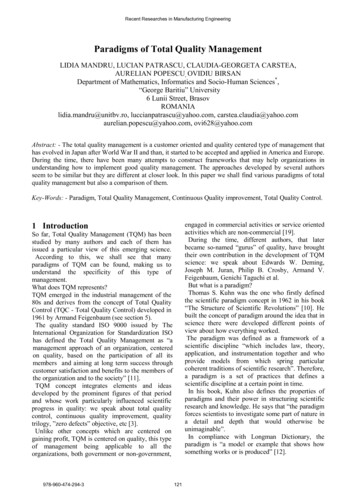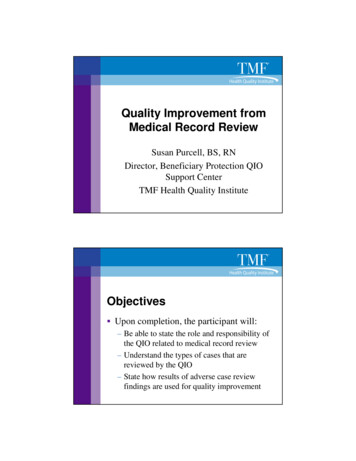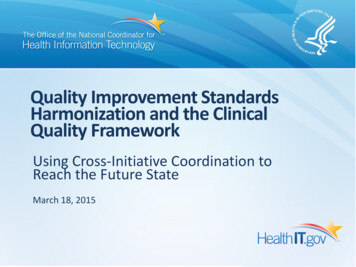
Transcription
Quality Improvement StandardsHarmonization and the ClinicalQuality FrameworkUsing Cross-Initiative Coordination toReach the Future StateMarch 18, 2015
Objectives Preview 2015 measure updatestandards/testing improvements Understand need for CDS/eCQM harmonization Learn about the planned pathway forCDS/eCQM standards harmonization:– Intermediate goals– Long term outcomes1
The Clinical Quality Framework:CURRENT STANDARDS/MEASURE UPDATE2
2015 eCQM Annual Update All 93 eCQMs to be published in HQMF R2.1 Current Measure Authoring Tool releasepackages include HQMF R2.1 file validation Value sets updated to include latest2014/2015 code systems Corrections to incorporate feedback fromusers and changes to other standards All measures pre-tested using BONNIE testingtool which creates QRDA libraries3
BONNIE: Test-Driven Development4
Motivation for HQMF R2.1 HQMF R2.1 much more tractable than HQMF R1– Easier to parse– Simpler execution model Intent to enable automated machine importing:––––Less effort than manual measure implementationLess chance of error than manual implementationFaster turnaround for measure updatesFix bugs in library code (e.g., temporal operators)once– Once you can import one measure you can rapidly addothers5
2014 Measure Logic for CMS1356
Proposed 2015 Measure Logic for CMS1357
The Clinical Quality Framework:ADDRESSING QI STANDARDS MISMATCH8
Why Harmonize Now? Clinical Decision Support (CDS) and electronic Clinical Quality Measurement(eCQM) are closely related, share many common requirements, and bothsupport improving health care quality– CDS recommends actions and eCQM measures impact/ care quality outcomes– Shared need to define patient cohorts– Shared need for standard ways to reference patient data9
The Challenge The standards used for the electronic representation of CDS and eCQM were notdeveloped in consideration of each other, and use different approaches to patientdata and computable expression logic.Patient DataClinical Decision Support Computable Expression LogicVirtual Medical Record (for bothphysical and logical models) CDS Knowledge ArtifactImplementation GuideQuality Reporting DataArchitecture (for physical model)Quality Data Model (for logicalmodel) Health Quality Measure Format(for physical model)Quality Data Model (for logicalmodel),Electronic Clinical QualityMeasurement (eCQM) Adhering to different standards places an additional implementation burden onvendors and providers with homegrown systems to build product-specific decisionsupport to support quality measures.It is currently difficult to share logic between eCQMs and CDS rules.10
The Clinical Quality Framework:CURRENT HARMONIZED QI STANDARDS11
Goal: Shared StandardsClinical Quality Measurement and Clinical Decision Support* Quality Improvement and Clinical Knowledge** Clinical Quality Language12
Clinical Quality Metadata Conceptual Model:Informational ballot published Feb 2015 Metadata is data about data. It is usedto classify an information artifact toenable that artifact to be retrieved,used, or quantified. Prior to this approach, the ClinicalQuality Improvement domainincluded several information modelswith a total of 18 different HL7standards with metadatarequirements. The Clinical Quality MetadataConceptual Model brings together therequirements for many CQIstandards/models and harmonizesthem into a single conceptual model.Common use cases for ClinicalQuality Metadata Conceptual Model: Health eDecisions (HeD) Decision Support Services (DSS) Health Quality Measures Format(HQMF) Virtual Medical Record (vMR) Quality Reporting DataArchitecture (QRDA) Templates Clinical Document Architecture(CDA) Order Sets13
Clinical Quality Language:DSTU balloted Jan 2015 (awaiting publication) Builds on functional requirements defined in:– Harmonization of Health Quality ArtifactReasoning and Expression Logic Leverages– Computability achieved by HeD– Measure Author understanding (QDM Heritage) Focus of the high-level syntax is on authoring– While providing a clear/automatic path tocomputable logic14
Chlamydia Screening, CQM15
Chlamydia Screening, CDS16
Authors use CQL to producelibraries containing humanreadable yet precise logic.ELM XML documents containmachine-friendly renderingof the CQL logic. This is theintended mechanism fordistribution of libraries.Implementationenvironments will eitherdirectly execute the ELM, orperform translation fromELM to their targetenvironment language.17
The Clinical Quality Framework:FUTURE HARMONIZED QI STANDARDS18
Proposed 2015 Standards Evolution19
Intermediate Approach:CQL-based HQMF Implementation Guide Ballot in submission for May 2015 Pros– Continued use of the QDM allows unchanged use of QRDAfor measure reporting– Only expression language changes, easier on measureproducers and consumers– Work on FHIR-based measure reporting standard can bedelayed until FHIR is more stable Cons– Creates inertia against QUICK introduction– QDM will require ongoing maintenance– Delays fully integrated eCQM CDS20
Proposed Post-2015 Standard21
QUICK and Quality FHIR Profiles QDM QUICK VMR QUICK: UML-based logicalmodel– initial plan to map toFHIR Resolved to auto-generateQUICK from Quality FHIRprofiles rather than hand-craft QUICK and Quality FHIR Profilesto be balloted for DSTU in 201522
Joint FHIR Profiles for Quality An S&I coordination effort led to realization ofan opportunity for common FHIR profilesacross CQF and DAF Discussion with the CIMI-HSPC team revealedfurther interest in coordination Current approach: QI Core common FHIRcontent for all three use cases withmodifications/further constraints23
Data Access Framework:Query Standard for Information ExchangeData AccessFrameworkLocal Access viaIntra-Organization Query Create and disseminate queries internal to organization Query Structure Layer API’s for Data Access Authentication/Authorization Layer Receive standardized responses Query Results LayerOrganization XTargeted Access viaInter-Organization Query Create and disseminate queries to single external organization Query Structure Layer Transport Layer Authentication/Authorization Layer Receive standardized responses from external orgs Query Results LayerOrganizationXOrganizationYMultiple Data Source Access viaDistributed Query (Query Health)- Completed Initiative Create and disseminate queries to multiple orgs Governed by a network Receive aggregated or de-identified responses Focus on Information Model for the network and leverage standards from earlier ueryResponseStandards based approach to enable access at all levels: Local, Targeted, and DistributedNote: An organization can be a hospital that is part of larger organization and can also include HIEs, RIOs, othertypes of organizations etc.24
CIMI: Clinical Information Modeling InitiativeHSPC: Health Services Platform Consortium02/01/2013HSPC25
Joint FHIR Profiles for Quality26
Questions?http://wiki.siframework.org/Clinical Quality Framework Initiative Initiative Coordination and Support: Ken Kawamoto, Marc Hadley, SarahRyan, Bridget Blake Community Contributors: various private and public sector contributors. E.g.,McKesson, Epic, Motive Medical Intelligence, Evinance, Wolters KluwerHealth, Zynx Health, National Decision Support Company, HLN Consulting,American College of Radiology, American College of Cardiology, HHS, CDC,universities and healthcare systems, and many othersHL7 sponsors: Clinical Quality Information Workgroup, Clinical Decision SupportWorkgroup, FHIR WorkgroupWork supported by Tacoma: a CMS-ONC sponsored activity ONC and CMS: Steve Posnack, Kate Goodrich, Julia Skapik(julia.skapik@hhs.gov), Minet Javellana, Laverne Perlie, Pavla Frazier27
BACKGROUND/ ADDITIONALCONTENT28
Quality Improvement Pathway :Ideal State29
QDM – Summary of 2015 Changes Some of the changes to QDM include: Ability to perform variable assignments Ability to add inline comments Introduction of new operators - Age At , Satisfies any / Satisfiesall, Overlaps Eight new temporal operators for including concurrency Approx 20 Datatypes/Attributes clarified / removed due toambiguity. Addition of General relationships. Total of 32 QDM changes since January 1, 2014 The current QDM specification can be found at:– http://www.healthit.gov/quality-data-model30
Quality Measurement (eCQM) Standards Measure Definition Standards– Quality Data Model (QDM)– Health Quality Measure Format (HQMF) Measure Reporting Standards– Quality Reporting Document Architecture (QRDA)– Category I for patient level data– Category III for aggregate data31
Clinical Decision Support (CDS) Standards HL7 standards from Health eDecisions (HeD)– Virtual Medical Record (vMR) data model– CDS Knowledge Artifact Specification (KAS) Rules, order sets, documentation templates– Decision Support Service (DSS) Spec and IG Aligned with other relevant standards– vMR: CCD, CCDA, QRDA, Infobutton– KAS: Order Set DSTU, GELLO, Arden, CDS Consortium– DSS: Infobutton, IHE Request for Clinical Guidance, REST32
Standards Status: March 2015 HQMF R2.1 published in Aug 2014– CQF-based HQMF IG comment-only ballot in Jan 2015 HeD KA R1.2 published in July 2014 CQL– Requirements balloted in Jan 2014– Comment-only ballot in Sept 2014, DSTU* ballot in Jan 2015 QUICK– Requirements (QIDAM) balloted in Jan and May 2014– Comment-only ballot in Sept 2014, DSTU ballot for May 2015 Quality FHIR Profiles– Comment-only ballot in Jan 2015, DSTU ballot for May 2015* Draft Standard for Trial Use33
Anatomy of a CQL Library using statements– Define the data model(s) in use by the library include statements– Define other libraries referenced by the library context definition– Define the overall context for the library (e.g. PATIENT or ENCOUNTER)– system-understood– in terms of the model parameter definitions– Define available “inputs” concept definitions– Define user-friendly labels for value sets within the library let statements– Define the expressions that are available within the library– Can be used by the containing artifact or other referencing libraries34
CMS 135 using CQL/QDMValueset definitions allow local names to be usedwithin the artifactIdentifiers can include spaces and punctuation tomake logic more readableFiltering is explicit in criteria, rather than implicit inthe modelEach define is a set, rather than a criteriadefinition, so “occurrencing” is not required35
Underlying Language and Data Source are both variableThere areways deviceuse could beinferred - ifnot, return“unknown”BLUE available conceptsDSL can reference high-levelconcept of “ChlamydiaTest”In the same waythat lower-levelconcepts can bereferencedIncluding theconceptsexplicitly definedin the “logicalmodel”Weimplementat least thise.g. as JavalibraryAs well as Data FormatSpecific concepts thatimplement a common“data provider”interface in terms ofthe logical modelBack end datastores36
Step-wise Movement to Future Standards37
Moving to Future Standards QUICK data model will be generatedautomatically directly from the completeFHIR profiles for Quality Goal is to facilitate a transition betweenexisting standards and future standardsthrough modularity Ongoing pilots will demonstrateimplementation feasibility and lead to furtherstandards refinement38
McKesson, Epic, Motive Medical Intelligence, Evinance, Wolters Kluwer . American College of Radiology, American College of Cardiology, HHS, CDC, universities and healthcare systems, and many others HL7 sponsors: Clinical Quality Information Workgroup, Clinical Decision Support Workgroup, FHIR Workgroup Work supported by Tacoma: a CMS-ONC .
